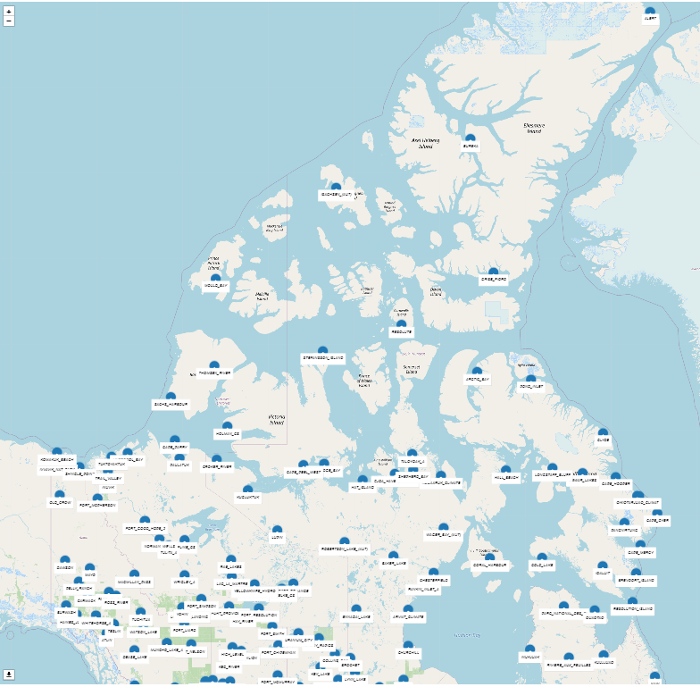Overview
Adjusted and homogenized Canadian climate data (AHCCD) consist of daily, monthly, seasonal and annual means of homogenized daily maximum, minimum and mean surface air temperatures for more than 330 locations in Canada. The data at stations incorporate adjustments (derived from statistical procedures) to the original historical station data to account for discontinuities from non-climatic factors, such as instrument changes or station relocation. Daily observations from nearby sites were often merged into a single record to create a long-time series. AHCCD was developed for use in climate research, including climate change studies.
Provider's contact information
Environment and Climate Change Canada
Contact cccs-ccsc@ec.gc.ca for information related to monthly, seasonal and annual data.
Contact ahccd@ec.gc.ca for information relate do daily data.
Licensing
Open Government Licence - Canada.
The end-user licence for Environment and Climate Change Canada's data servers specifies the conditions of use of this data.
Variable name and units:
Maximum temperature in degree Celsius (°C);
Minimum temperature in degree Celsius (°C);
Mean temperature in degree Celsius (°C);
Spatial coverage and resolution:
Canada, point location.
Temporal coverage and resolution:
Time period varies per station with data for most stations in the North starting in 40’s or 50’s and ending in 2017.
The data is available at daily, monthly, seasonal, annual time steps.
The data will continue to be updated regularly.
Information about observations (number, homogeneity)
This new dataset includes the observations taken at Reference Climate Stations and from some of the NavCan sites, which are used to extend past climate observations into recent times. The following table presents the number of stations per region and variable:
| Region | Temperature |
|---|---|
| Yukon | 18 |
| NWT | 31 |
| Nunavut | 40 |
| North Quebec | 15 |
| Labrador | 8 |
The figure below show the position of the stations for northern Canada.

Methodology
The daily AHCCD station data are derived from observations made at the weather stations from the Meteorological Service of Canada (MSC) and use the same ID as MSC stations; this allows users to compare the raw station data to homogenized and adjusted data. The AHCCD dataset was developed for use in climate research, including climate change studies that needs long-term data records. Over long periods, meteorological records are subject of changes (e.g., site exposure, location, instrumentation, observer, and observing procedures) that are not related to climate. These non-climatic changes were detected and removed in AHCCD using statistical procedures.
The daily data were developed first for daily maximum temperature and daily minimum temperature using MSC daily observations. The MSC daily data are derived from two sources depending on if the station has an automatic hourly sensor (most do now):
- hourly (temperatures are reported every hour and then the maximum temperature of the day and minimum temperature of the day are reported as daily max/min values), and
- daily (using a thermometer just for maximum temperature and a thermometer just for minimum temperature that are reported twice a day).
In AHCCD data, the daily minimum temperatures were adjusted for the change in observing time in 1961 at principal stations. Parallel daily data were used to detect non-climatic shifts when the observations of nearby sites were merged together. Daily temperatures were adjusted using a Quantile-Matching procedure to remove inhomogeneities if needed. The procedures are described in Vincent et al., (2020).
Daily mean temperatures were calculated as the average of daily minimum and maximum temperatures. The monthly values for maximum (or minimum) temperature were computed as the average of daily values over the month and were set to missing if more than eight random or five consecutive daily values in the month were missing. Annual and seasonal means were calculated from the monthly values and retained if all related monthly values are non missing. The seasons are defined as winter (December of the previous year to February of the current year), spring (March–May), summer (June–August), and autumn (September–November):
Series of annual and seasonal mean temperatures were tested separately for homogeneity using neighbour observations as a reference series.
Information about the technical and scientific quality
The data were quality controlled (information is provided in Vincent et al., (2020)) and use up-to-date methods. For temperature, the third version was released in December 2020. The data will continue to be updated periodically.
The dataset is accompanied by a technical documentation and a scientific paper.
Limitations and strengths for application in North Canada
The data constitute the longest records at stations that were adjusted to eliminate non-climatic shifts and take into account the change in observing time. Data availability over most of the Canadian Arctic is restricted to the mid-1940s to 2017. This dataset is usually used to validate other historical datasets estimated using various models or methodologies.
The major limitation for applications in the North is the number restrained of locations with a record. As any data at stations, it has missing values, which may vary by variable, station and time. The missing values in daily records were taken into account when monthly, seasonal and annual data was developed (see methodology section).
References to documents describing the methodology or/and the dataset
Vincent, L.A., M.M. Hartwell, and W. L. Wang, 2020: A Third Generation of Homogenized Temperature for Trend Analysis and Monitoring Changes in Canada’s Climate. Atmosphere-Ocean. https://doi.org/10.1080/07055900.2020.1765728.
Technical documentation: http://crd-data-donnees-rdc.ec.gc.ca/CDAS/products/AHCCD/Temperature_Documentation_Gen3.doc
Link to download the data and format of data:
For daily data:
http://crd-data-donnees-rdc.ec.gc.ca/CDAS/products/AHCCD_daily/ (.txt on CRD/ECCC webpage)
https://climatedata.ca/download/#ahccd-download (this will be available in the following months)
For monthly, seasonal and annual data:
https://climate-change.canada.ca/climate-data/#/adjusted-station-data (GeoJSON and CSV on CCCS/ECCC webpage)
http://crd-data-donnees-rdc.ec.gc.ca/CDAS/products/AHCCD/ (.txt on CRD/ECCC webpage)
On MSC Datamart at https://dd.weather.gc.ca/climate/ahccd/geojson/historical/ (GeoJSON)
Publications including dataset evaluation or comparison with other data in northern Canada.
This dataset is usually used as reference in the evaluation of climate variables from other datasets.